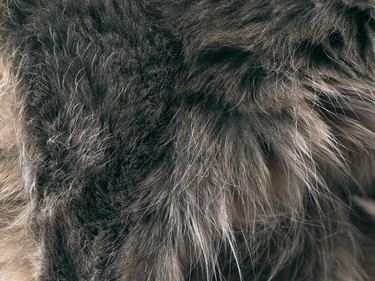Dogs can suffer from a variety of itchy, annoying skin ailments just like their human friends. One such ailment is an ingrown hair, which is caused when a hair becomes entrapped and continues to grow within the sheath of the hair follicle without emerging from the surface skin layer.
Infected ingrown hairs are a form of superficial bacterial folliculitis — surface-layer bacterial infection of hair follicles — which is a form of canine pyoderma, or skin infection.
Video of the Day
Video of the Day

Can dogs get ingrown hairs?
A preexisting case of pyoderma can cause an ingrown hair by causing tissue changes that trap the hair. Infection can result from tissue irritation and bacteria introduced by the trapped hair. Most follicular infections are caused by Staphylococcus pseudintermedius, but they may be caused by other species of Staphylococcus or by Streptococcus or Pseudomonas bacteria.
These bacteria do not normally grow on a dog's skin but are naturally present on dog fur. When they get underneath the skin surface, they cause infection. This infection leads to pus-filled packets inside the hair follicles. In rare cases, swollen, pus-filled follicles are caused by other types of bacteria, autoimmune disease, or an allergy-like sensitivity to normal bacteria or yeasts on the skin or hair.
Some types of dogs are especially prone to infection of the hair follicles, including spaniels, setters, retrievers, hounds, schnauzers, and poodles. Dogs who are shaved are at greater risk of developing impacted hair follicles, which lead to ingrown hairs. Ingrown dog whiskers or hairs are more likely on areas with prior skin damage.
Overbathing and improper grooming techniques increase the risk of ingrown hairs and bacterial folliculitis for dogs of any breed. Individual dogs may be genetically predisposed to these conditions.

What are the symptoms of ingrown hair on dogs?
Ingrown hair on dogs often presents as swollen, red, pimple-like bumps that develop into pustules that reveal the long, trapped hair when burst. However, a dog ingrown hair can also appear as a variety of skin irritations, including crusty areas or bumpy, bald patches.
As ingrown hairs can develop on fur-covered areas that are not readily visible, your first warning may come from your pet's behavior. Behavioral symptoms include persistent scratching or chewing at the skin. In dogs with short coats, ingrown hair and folliculitis are commonly found on areas with sparser fur, such as the abdomen. In breeds with long, curling hair, such as poodles, they can develop anywhere on the body.
Chronic or pervasive cases of superficial bacterial folliculitis are usually a symptom of an underlying disease condition, such as hypothyroidism, chronic inflammation from severe allergies, chronic demodex mite overgrowth (demodicosis), and Cushing's disease (which results in the adrenal glands producing too much cortisol).
It is important to seek veterinary attention to determine the nature of and treat underlying causes. Diagnosis may be made through visual exam, skin cytology (to evaluate yeast and bacteria found on your dog's skin), and bacterial and fungal cultures from skin scrapings or pus.
Certain other diseases, such as tumors of the hair follicle and mange, can resemble ingrown hairs in the early stages. A veterinary exam is necessary to rule them out.

Treatment and warnings of folliculitis in dogs
A single incidence of ingrown hair may be left alone to resolve on its own, or it may be treated with a topical scrub or lanced if severe. More pervasive cases of folliculitis that affect entire patches of skin are treated by oral antibiotics and sometimes by topical antiseptic shampoos, conditioners, creams, lotions, sprays, or gels.
Antibiotic therapy usually lasts a minimum of three weeks, though it can vary. Topical therapy typically lasts at least one to two weeks, with regular applications thereafter as prescribed.
Do not attempt to burst infected follicles, as this can increase irritation, further damage the tissues, and spread infection-causing bacteria. Untreated superficial bacterial folliculitis can lead to more serious and pervasive skin infections. Bring your dog to a veterinarian if you notice any signs of skin inflammation.